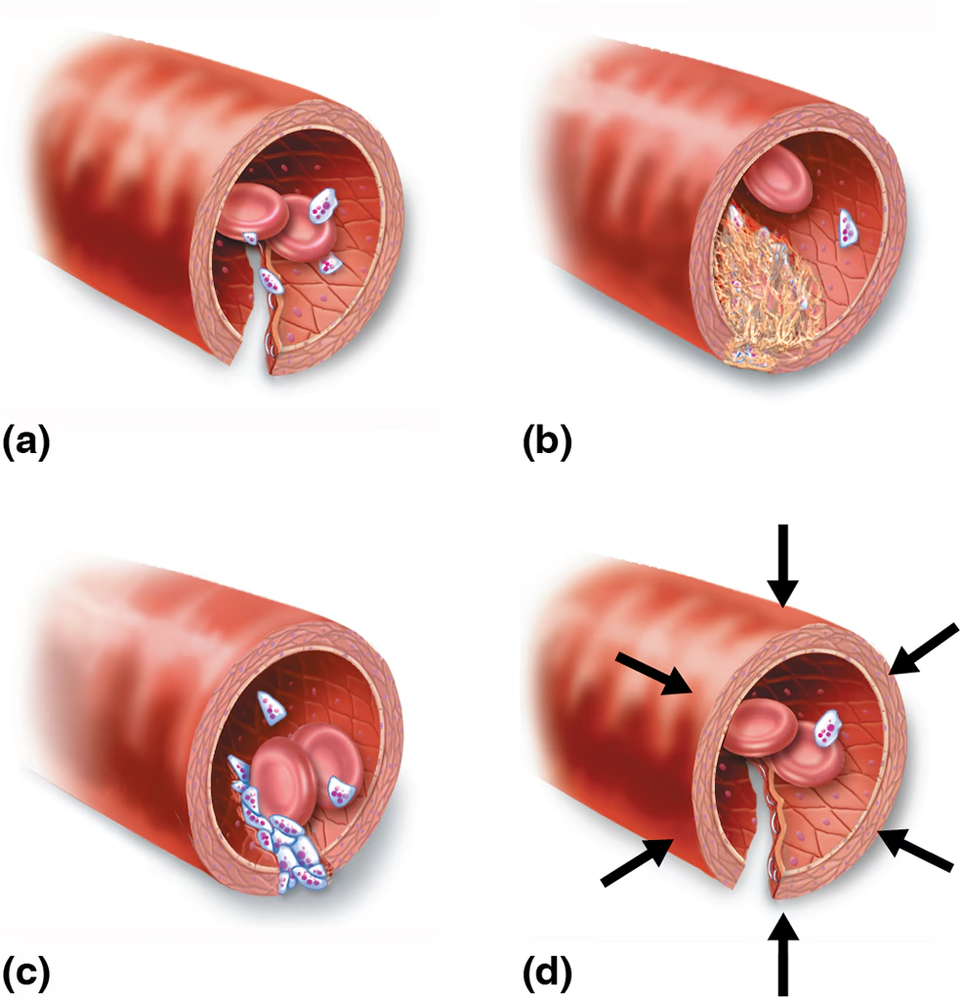 Back
BackProblem 1
More than one choice may apply.
Which would lead to increased erythropoiesis?
a. Chronic bleeding ulcer
b. Reduction in respiratory ventilation
c. Decreased level of physical activity
d. Reduced blood flow to the kidneys
Problem 2
More than one choice may apply.
In a person with sickle cell anemia, sickling of RBCs can be induced by
a. Blood loss
b. Vigorous exercise
c. Stress
d. Fever
Problem 3
More than one choice may apply. A child is diagnosed with sickle cell anemia. This means that
a. One parent had sickle cell anemia.
b. One parent carried the sickle cell gene.
c. Both parents had sickle cell anemia.
d. Both parents carried the sickle cell gene.
Problem 4
More than one choice may apply.
Polycythemia vera will result in
a. Overproduction of WBCs
b. Exceptionally high blood volume
c. Abnormally high blood viscosity
d. Abnormally low hematocrit
Problem 5
More than one choice may apply.
Which of the following is not typical of leukocytes?
a. Amoeboid movement
b. Phagocytic (some)
c. Nucleated cells
d. The most numerous cells in the bloodstream
Problem 6
More than one choice may apply.
The leukocyte that releases histamine and other inflammatory chemicals is the
a. Basophil
b. Monocyte
c. Eosinophil
e. Neutrophil
Problem 7
More than one choice may apply.
Which of the following formed elements are phagocytic?
a. Erythrocytes
b. Neutrophils
c. Monocytes
d. Lymphocytes
Problem 8
More than one choice may apply.
A condition resulting from thrombocytopenia is
a. Thrombus formation
b. Embolus formation
c. Petechiae
d. Hemophilia
Problem 10
More than one choice may apply.
If an Rh ⁻ mother becomes pregnant, when can hemolytic disease of the newborn not possibly occur in the child?
a. If the child is Rh ⁻
b. If the child is Rh⁺
c. If the father is Rh⁺
d. If the father is Rh ⁻
Problem 11
More than one choice may apply. Plasma without the clotting proteins is called
a. Serum
b. Whole blood
c. Fibrin
d. Tissue factor
Problem 12
Albumin
a. is a blood buffer.
b. helps maintain blood's osmotic pressure.
c. distributes body heat.
d. transports certain molecules.
Problem 13
More than one choice may apply.
Place the letters of these events in the order they occur during hemostasis.
Problem 14
Name as many different categories of substances carried in plasma as you can.
Problem 15
Define anemia, and give three possible causes.
Problem 16
Name the formed elements that arise from myeloid stem cells. Name those arising from lymphoid stem cells.
Problem 17
How can liver dysfunction cause bleeding disorders?
Problem 21
If you had a high hematocrit, would you expect your hemoglobin determination to be high or low? Why?
Problem 22
A bone marrow biopsy of Mr. Lee, a man on long-term drug therapy, shows an abnormally high percentage of nonhematopoietic connective tissue. What condition does this indicate? If the symptoms are critical, what short-term and long-term treatments are indicated? Which treatment is he more likely to be given: infusion of whole blood or of packed red cells?
Problem 23
A woman comes to the clinic complaining of fatigue, shortness of breath, and chills. Blood tests show anemia, and a bleeding ulcer is diagnosed. What type of anemia is this?
Problem 24
Lymphocytes continuously circulate through the body using blood and lymph as their transport vehicles. What is the importance of this recirculation behavior?
Problem 24
A middle-aged college professor from Boston is in the Swiss Alps studying astronomy. He arrived two days ago and plans to stay the entire year. However, he notices that he is short of breath when he walks up steps and that he tires easily with any physical activity. His symptoms gradually disappear; after two months, he feels fine. Upon returning to the United States, he has a complete physical exam and is told that his erythrocyte count is higher than normal.
(a) Attempt to explain this finding.
(b) Will his RBC count remain at this higher-than-normal level? Why or why not?
Problem 25
Brittany, a healthy young woman, had a battery of tests during a physical for a new job. Her RBC count was at the higher end of the normal range at that time, but four weeks later it was substantially elevated beyond that. When asked if any circumstances had changed in her life, she admitted to taking up smoking. How might her new habit explain her higher RBC count?

